The clown tang brings much to the table for the saltwater aquarium enthusiast.
They are a large species that is vibrantly colored, has an engaging personality, and is one of the more reef-safe tangs you can find.
They go by many names, including the lined surgeonfish, blue-banded surgeonfish, and clown surgeonfish.
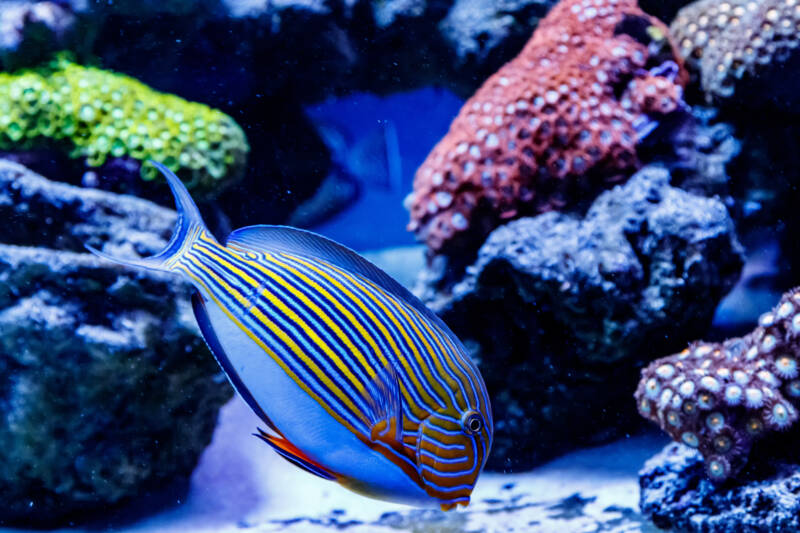
If you are thinking of getting a clown tang, there are a few things you should know to keep them happy and healthy.
Read on for valuable information about acclimating, feeding, and housing these wonderful fish.
[toc]
At a Glance
| Tank Size: | 250 gallons (950 l) |
| Group Size: | Single specimen |
| Water Temperature: | 75 to 82°F (24 to 28°C) |
| pH: | 8.1 to 8.4 |
| Hardness: | 8 to 12 dKH |
| Specific Gravity: | 1.020 to 1.025 |
| Lifespan: | 10 years |
| Breeding: | Difficult in captivity |
| Adult Size: | 15 inches (38 cm) |
| Usual Place in the Tank: | All levels |
Natural Habitat
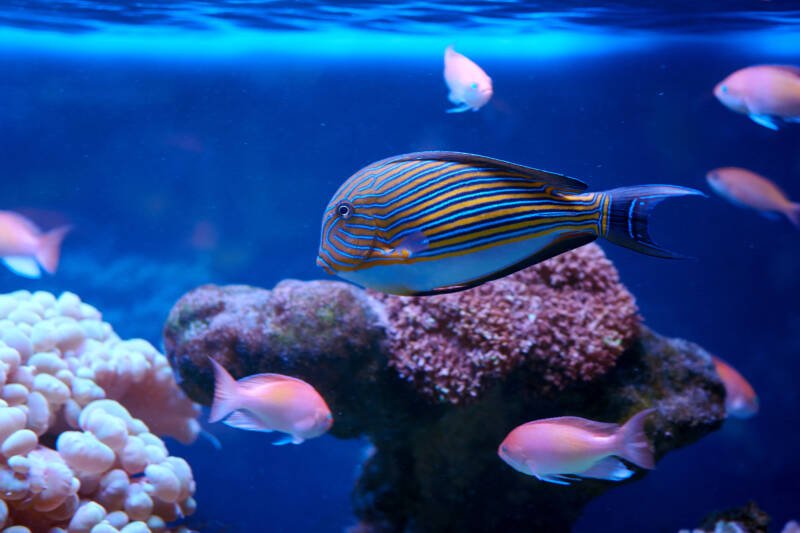
The clown tang (Acanthurus lineatus) is native to the waters of Fiji, Maldives, and New Caledonia.
They thrive in areas rich with coral reefs and a strong current.
Appearance and Biology
This fish has either a yellow or orange body with contrasting light and dark blue horizontal stripes.
Their belly is white, and the black highlights on the fins make the colors pop.
The clown tang has a distinctive disc shape due to its extended dorsal and anal fins. In fact, when the tang stretches out these fins, this fish measures as tall as it does long!
Their tail fin is deeply forked in adulthood but is more rounded when the fish are juveniles.
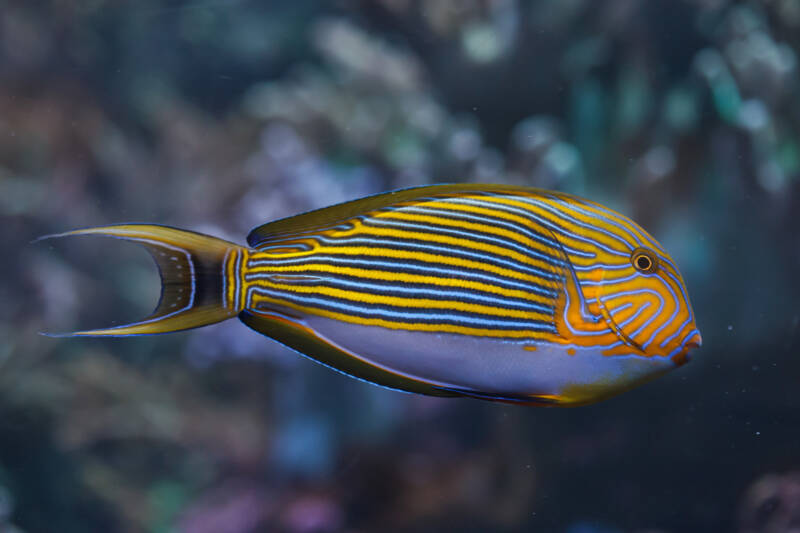
At the base of the tail are peduncle spines. These razor-sharp extensions serve for both defense and for guarding territory from intruders.
Always take care when transporting your clown tang. These spines can cut skin or become trapped in netting, so always use a solid container.
Gender Differences
Unfortunately, it is difficult to quickly differentiate male versus female. If all the fish are the same age, females are slightly larger.
Size
You may purchase these fish as small as 1.5 inches (4 cm) but know that they will eventually reach an adult length of 15 inches (38 cm).
Lifespan
Your fish can live for ten years with an appropriately sized tank, clean water, and proper nutrition.
It is interesting to note that their lifespan in the wild is 25 to 30 years. The stresses of transport and captivity shorten their lifespan significantly.
Behavior
The clown tang has a well-deserved reputation for territorial behavior.
They are equally aggressive toward their own species, similarly shaped tangs, and other species that look like them.
The clown tang will even take on fish that are larger than it is.
While they may get along well in a group as juveniles, do not be fooled into thinking they will behave this way as adults.
How many per gallon?
Due to their territorial nature and aggression, keeping the clown tang as a single specimen is best.
Tank setup
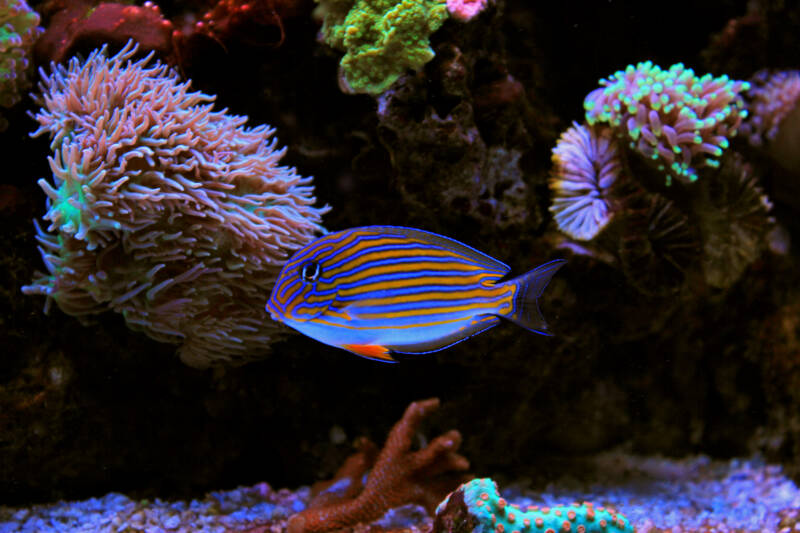
These large fish need at least a 250-gallon (950 l) tank that is six feet (1.8 m) in length to allow these active swimmers ample room.
The space will help to keep their stress levels low.
Decorations
Adding live rock to the tank will create surfaces on which algae can grow. Your tang will enjoy snacking on this food source in between meals.
The rock does double duty, offering multiple hiding places for your tangs to duck into as needed.
Water Conditions
Clown tangs need meticulously maintained water. In addition to regular cleanings, keep the water parameters in the following ranges:
- Specific Gravity: 1.020-1.025
- Temperature: 75 to 82°F (24 to 28°C)
- Hardness: 8 to 12 dKH
- pH: 8.1 to 8.4
Equipment
Filter, filter, and filter your water. Install quality mechanical, biological, and protein filters suited to the large tank you will have to maintain pristine conditions.
As these fish require highly oxygenated water and a strong current, consider a power head, wave maker, or filter with a hefty water flow.
Keep a tight-fitting lid on your tank as tangs are skilled jumpers.
Acclimating Your Fish
Do not immediately place your clown tang in your community tank.
Quarantine First
These fish can develop ich due to the stresses involved in transport and should always be quarantined so as not to infect the community tank.
Get Them to Eat
While they are in quarantine, encourage them to eat, which can be one of the biggest challenges when you first bring them home.
These wild-caught fish are incredibly stressed by the collection and transport process and will often not eat during their initial time in captivity.
Offer marine algae or seaweed clipped underneath a rock in their habitat. Observe them closely in their first few days to see if they begin to nibble at the offering. Replenish the supply three times a week.
Transfer to the Community Tank
When you are ready to move your fish to the community tank, drip in the tank water for at least 60 minutes at three drips per second.
Use a container to transfer the fish to the community tank with minimal transfer of the quarantine tank water.
If you keep the clown tang with other species, introduce the tang to the tank last. This will help reduce the tang’s territorial behavior among the already established fish.
Tank Mates

Clown tangs can live with other species in a community tank if you take care in your selection.
Consider the following to pair with your clown tang:
- Tangs and saltwater fish with different body shapes and colors (look for aggression and be prepared to remove them if needed)
- Cleaner shrimp
- Anemones
- Starfish
Avoid the following:
- Other clown tangs
- Tangs with the same color and shape as clown tangs
- Other fish species with a similar body shape or color.
Are clown tangs reef safe?
Yes. Unlike other surgeonfish species, clown tangs will leave your LPS and SPS corals alone.
They can help maintain the cleanliness of your tank by feeding off the filamentous algae that grow within.
Food and Diet
Clown tangs are omnivores with a diet heavy in vegetable-based foods. Therefore, the importance of having adequate greens in their diet cannot be overstated.
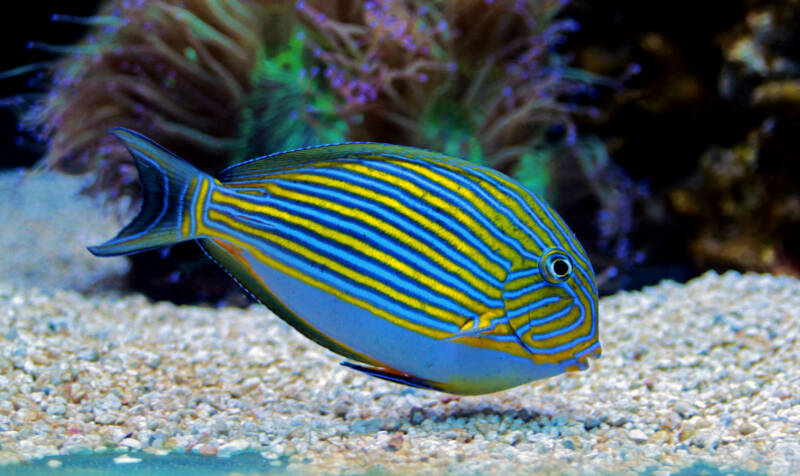
Feed them algae or seaweed at least three times a week so they do not develop head and lateral line erosion (HLLE).
They will also accept live and frozen meaty foods, such as mysis or brine shrimp, tubifex, or krill.
Take care to not overfeed these fish as they will readily gobble up everything you put in the tank.
If keeping them with other species, make sure the tangs are not taking all the food, leaving the other fish deprived.
Breeding
The clown tang is an egg-scattering species that forms pairs to spawn in the wild.
However, they are quite difficult to breed in captivity, and we do not recommend an attempt for most aquarists.
Closing Thoughts
Although the clown tang presents challenges in terms of feeding and housing, its activity, personality, and beauty keep it high on the list of beloved saltwater fish.
The required preparation and attention to care are well worth the joy this fish brings.
We would love to hear about your experiences in keeping clown tangs!
What foods do you find work best during the acclimation period?
